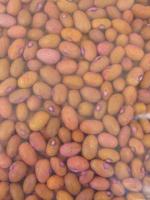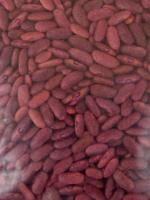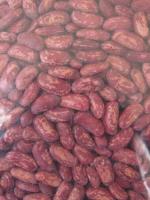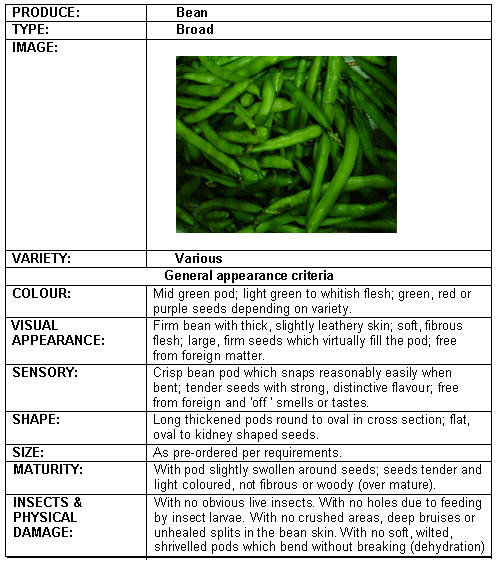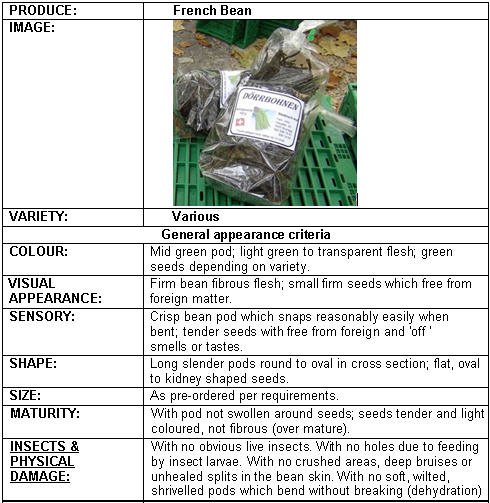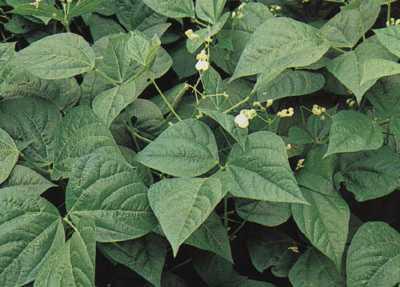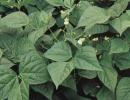
|
Beans
Scientific name:
Phaseolus vulgaris L.
Order/Family:
Fabales: Fabaceae
Local names:
Maharagwe (Swahili), Mishiri (Kikuyu)
Common names:
Bush beans, common beans, dry beans, dwarf beans, field beans, French beans (also known as green beans or snap beans), garden beans, haricot beans, kidney beans, pole beans or string beans
Pests and Diseases:
African bollworm
Angular leaf spots
Anthracnose
Aphids
Bean common mosaic virus
Bean flies
Bean rust
Bean seed flies
Broomrape
Bugs
Common blight
Cutworms
Flower or blister beetles
Foliage beetles
Fusarium wilt
Halo blight
Leafhoppers
Leafmining flies (leafminers)
Powdery mildew
Root-knot nematodes
Snails (Giant East African Snail)
Spider mites
Storage pests
Stripped been weevil
Thrips
Tomato Yellow Leaf Curl Virus Disease (TYLCV)
Whiteflies
|
African bollworm and other pod borers
Several caterpillars are important pests as pod borers in common beans and French beans. The most common are the African bollworm (Helicoverpa armigera) and the legume pod borer (Maruca testulalis). They feed on leaves, flowers, pods and seeds.
The African bollworm caterpillars are 3 to 4 cm long. They make clean circular holes in the pods. One caterpillar may damage several pods. Caterpillars of the legume pod borer attack pods at the point of contact with other pods, leaves or the stem. They frequently web together flowers, pods and leaves with excrements.
Pod borers usually do not cause significant yield reduction in beans. However, they are quarantine pests, and are particularly important in French beans grown for export. If only 1 caterpillar is found in a consignment sent to Europe, the whole consignment may be rejected.
If pod borers are found in a field, the beans harvested should be sorted very thoroughly to remove the bollworms manually.
- Monitor the crop regularly
- Handpick and destroy infested pods and pod borers. This helps when their numbers are low and in small fields.
- Spray crop with biological pesticides (e.g. Bt products or neem). For more information on neem click here. For information on Bt click here
- If pod borers are found in a French beans field, sort harvested pods very thoroughly and remove pod borers manually.
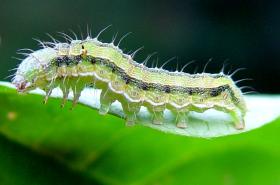
© A.M. Varela, icipe
Angular leaf spot (Phaeoisariopsis griseola)
Symptoms consist of small dark brown spots with angular edges and are often numerous to give the foliage a checker-board appearance. The spots may increase in size, join together, and cause yellowing and necrosis of the affected leaves. This may lead to premature defoliation. When humid, the fungus produces a grey mould on the lower surface of the spots. Infected pods have brown blotches. The disease is favoured by high moisture and moderate temperatures (20-25°C). The disease is seed-borne.
- Use certified disease-free seed.
- Plough under bean debris after harvest.
- Practise a 2-3 year crop rotation without legumes.
- Do not work in bean fields when the plants are wet.
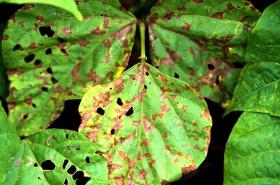
© A.M. Varela, icipe
Anthracnose (Colletotrichum lindemuthianum)
Symptoms of anthracnose can appear on any plant part. Pale brown sunken spots may appear on the cotyledons of infected seedlings. Water may spread the disease to the hypocotyl, which if girdled, kills the seedling. Lesions on leaves are dark brown. They are restricted to the veins on lower leaf surface. On stems, lesions are elongated and sunken. On the pods, the fungus produces black, sunken lesions. These lesions penetrate deep into the pods and may cause shrivelling of the young pods. Infected seed become discoloured changing to yellow through brown to black. In damp weather, the centres of anthracnose lesions become covered with a pink spore mass. The disease is seed-borne.
- Use certified disease-free seeds. Plant resistant varieties (e.g. French variety 'Paulista').
- Remove from the field and destroy crop debris after harvest.
- Practise a 2 to 3 year rotation.
- Avoid overhead irrigation.
- Avoid movement of workers in the field when wet.
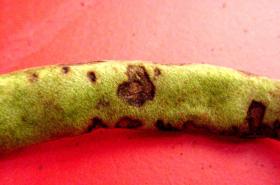
© A.M. Varela, icipe
Aphids (Aphis fabae) and (Aphis craccivora)
The black bean aphid (Aphis fabae) and the black legume aphid (Aphis craccivora)
are black to dark brown brownish in colour and winged or wingless and vary in size from 1.5 to 3.0 mm. Aphids feed by sucking plant sap. Small aphid populations may be relatively harmless, but heavily infested plants usually have wrinkled leaves, stunted growth and deformed pods. Plants, in particular young plants, may dry out and die under heavy aphid attack. Heavy attack on older plants may cause crop loss by decreasing flower and pod production. Damage may also reduce seed viability.
In addition, plants may become contaminated by honeydew produced by aphids and sooty mould growing on honeydew. French beans contaminated with honeydew and / or sooty moulds are not marketable. Aphids are also vectors of diseases, including the bean common mosaic virus. The black bean aphid is a widely distributed pest of beans. The black legume aphid usually attacks beans grown at low altitudes.
- Conserve natural enemies. They are important in natural control of aphids. For more information on natural enemies click here
- Monitor regularly the crop.
- Whenever necessary spray only infested plants (spot spraying).
- Use biopesticides that are not harmful to natural enemies (e.g. neem, ashes, soapy water). In Kenya, foliar sprays with neem products such as Neemroc® (1-3%) and Neemros® water extract (50g/l) controlled the black bean aphid on French beans (Maundu, 1997). For more information on biopesticides click here
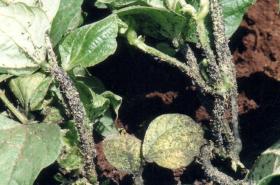
© A.M. Varela, icipe
Bean common mosaic virus
Symptoms of bean common mosaic virus (BCMV) are cupping and twisting of leaves with a light and dark green mosaic pattern. The dark green tissue is often bubbled and/or in bands next to the veins. Affected plants produce smaller, curled pods with a greasy appearance, and yields are reduced. The virus is seed borne. It can be transmitted by several aphid species.
- Use certified and disease-free seeds
- Plant resistant varieties (e.g. French bean variety 'Paulista')
- Control attacks of aphids
- Remove infected plants from the field
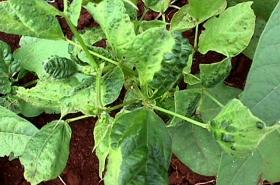
© A.A. Seif, icipe
Bean flies (Ophiomyia spp.)
Bean flies also called bean stem maggots are serious pests in Africa. The adult is a tiny (about 2mm long) fly, shiny black-bluish in colour. The female fly pierces the young leaves to lay eggs and sucks the exuding sap. This leaves yellow blotches on the leaves, which are the first signs of bean fly attack and may serve as early symptom useful for monitoring the presence of this pest in the field. Maggots mine their way from the leaves down to the base of the stem, where they complete their development.
Maggot feeding destroys the tissue causing the stem to swell and split and reducing formation of lateral roots. Attacked plants produce adventitious roots in compensation. Maggots (yellow in colour) and pupae (brown or black in colour) can often be seen through the stem splits. Young seedlings and plants under stress wilt and die when attacked by bean flies. Older or vigorous plants may tolerate bean fly attack, but their growth will be stunted and their yield reduced. Damage is more severe in plants growing under poor conditions such as infertile soils and drought.
- Plant early in the season. Bean fly numbers tend to be low during the early stages of the growing season and increase with time.
- Provide favourable growing conditions to improve plant vigour and to enhance tolerance to insect attack and damage. For instance, soil fertility can be improved by adding organic fertilisers and well decomposed farmyard manure.
- Mulch (e.g. with straw and cut grasses) helps conserve moisture, promote adventitious root development and enhances tolerance to maggot damage.
- Avoid planting beans near cowpea, soybean and many other leguminous crops, that may be the source of bean flies.
- Remove and destroy crop residues and all plant parts with symptoms of damage by bean flies.
- Earth up (building up) the soil around the plants to cover the roots at 2-3 weeks after emergence helps the adventitious roots to grow more quickly. If there is enough moisture, the plants are able to recover from the damage.
- Use botanical insecticides such as neem. It has been shown that frequent foliar application with neem extract gives satisfactory control of this pest.
- Use resistant varieties: Several lines of dry beans have been identified as having good levels of resistance to bean flies in East Africa. These lines are available form the CIAT Regional Programme and from national agricultural research programmes in the region.

© A.M. Varela, icipe

Bean fly

Bean fly
Bean rust (Uromyces appendiculatus var. appendiculatus)
Rust spots (pustules) appear on all parts above the ground. They are most numerous on leaves, particularly on the underside. They are less abundant on stems and occur sparingly on pods. Initial symptoms are minute, slightly raised yellow pustules, which later become distinct circles, reddish brown in colour and surrounded by a yellow halo. The disease is spread long distance by wind. Plant to plant spread of the disease is by farm tools, insects or water splash. Severely infected leaves drop off.
- Destroy crop residues after harvesting.
- Avoid continuous cropping of beans.
- Practise a 2 to 3 year crop rotation without legumes.
- Intercrop with cereals.
- Plant resistant varieties where available (e.g. French bean varieties 'Theresa' and "Super Monet").
- A number of pesticides are available in the market. There are reports claiming that baking soda, compost tea spray, EM (effective microorganisms) and papaya leaf extract control bean rust.
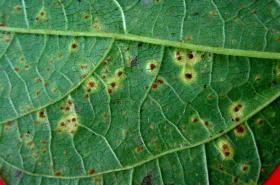
© A. M. Varela, icipe
The bean seed fly (Delia platura)
The bean seed fly, also known as seed corn maggot, resembles small houseflies. It is about 1cm long.
Female flies are attracted to recently disturbed open soil, where they lay eggs, especially where there are plant residues or when large amount of manure has been applied. The maggots bore into germinating bean seeds or the cotyledons (first seed leaves) of the young plant eating them. This causes patchy emergence of seedlings. If damaged plants emerge, they are stunted, weak and fail to develop into productive plants.
Pupation takes place in the soil, 2-4 cm under the soil surface.
- Limit the amount of organic matter before planting in areas with a known history of bean seed flies.
- Avoid sowing into recently ploughed land in areas where this fly is a problem.
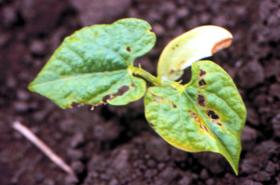
© A.M. Varela, icipe
Bugs
Several species of bugs feed on beans. The most common in East Africa are the spiny brown bug (Clavigralla tomentosicolis), Riptortus bugs (Riptortus dentipes), the green stink bug (Nezara viridula) and the tip wilter (Anoplocnemis curvipes).
Bugs suck on pods causing tiny lesions, and may cause shrivelling and rotting of the seeds, which lose viability. The whole pod may also shrivel. French bean pods showing signs of bug attack (pimples) are not marketable. Tip wilters sometimes suck the sap on shoots, causing them to wilt and turn necrotic and rot. The green stinkbug transmits a fungus to developing seeds, causing yeast spot, which is a widespread but a minor disease of beans in Africa.
Bugs are difficult to control since they usually feed on a wide range of crops and are very mobile.
- Bugs can be collected by hand regularly and killed, especially during flowering and pod formation.
- Natural enemies such as assassin bugs, spiders, praying mantises and ants are important natural enemies of bugs. They kill or deter bugs. Conserve and attract predatory natural enemies to your crop by planting flowering plants. For more information on natural enemies click here
- Neem products are reported to repel bugs. If necessary spraying should be done in the morning when the immature stages are exposed
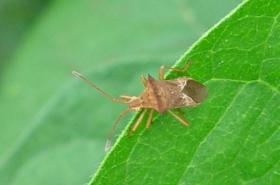
© A.M. Varela, icipe

Spiny brow…

Tip wilter…

Riptortus …

Stink bug
Common blight (Xanthomonas axonopodis pv. phaseoli)
This disease is a constraint to bean production in Kenya. Crop losses of between 10 and 75% have been reported. The common blight produces similar symptoms on leaves, pods, stems and seeds. Small water-soaked spots are the first symptoms observed on leaves and appear within 4 to 10 days of infection. As the spots develop, the centre becomes dry and brown. The lesion is surrounded by a narrow band of bright yellow tissue. However, yellowed tissue is occasionally absent.
- Intercropping bean with maize was shown to reduce the severity of common bacterial blight during 1987-88 in Tanzania.
- Use certified disease-free seed.
- Plant resistant varieties (e.g. French bean variety 'Paulista').
- Plough under bean debris after harvest.
- Practise a 2-3 year crop rotation without legumes.
- Do not work in bean fields when the plants are wet.
- If blight is observed on scattered plants, spot application of copper hydroxide could be considered.
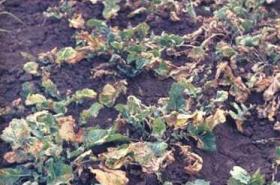
© Jürgen Kranz, (www.ecoport.org)
Cutworms
Cutworms attack young seedlings. First instars are 0.7-1 cm, later instars are 3.5-5cm long. The caterpillar emerges from the soil at night, encircles the plant with its body and cut through the stem of young plants just above ground level. They may also damage the plants underground. Cutworm damage causes plants to wilt and die. Cutworm damage is usually minor and does not normally warrant control. However, in severe outbreaks a young crop may be destroyed.
- Monitor damage by counting damaged and freshly cut young plants. Monitor cutworm at dawn.
- Remove and destroy cutworms.
- Prepare field and remove weeds well ahead (10-14 days) of planting the crop in the field. Ploughing exposes caterpillars to predators and to desiccation by the sun. If the field is planted soon after land preparation some cutworms may be alive and attack the new crop.
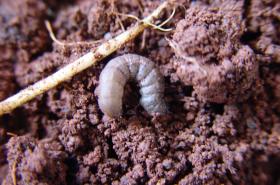
© A.M. Varela, icipe
Flower or blister beetles (Mylabris oculata)
The adults of the flower beetles, also known as blister beetles, feed on bean flowers (petals and / or pollen) reducing pod set. The adults are medium to large sized beetles (2-5 cm in length), usually black and yellow or black and red in colour. The immature stages (larvae) do not feed on plants. They live in the soil and eat grasshopper eggs.
- Hand-pick and destroy adult beetles to keep the numbers in check. However, care should be taken, since when disturbed, blister beetles can release a liquid that burn the skin. Whenever possible wear gloves to protect the hands
- Do not destroy the larvae, as they are beneficial (they feed on grasshopper eggs)
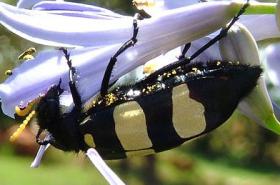
© Botha AD (Courtesy of EcoPort, www.ecoport.org)
Foliage beetles (Ootheca spp.; Monolepta spp.)
In East Africa foliage beetles (Ootheca spp.; Monolepta spp.) are commonly found feeding on bean leaves. Foliage beetles chew small round holes in the leaves. They are about 4-7mm long. They may be a serious problem when present in large numbers or when attacking young plants. Heavy attacks may cause defoliation. Attack on young plants may reduce plant vigour, plant size and yield. The problem is more acute in fields with continuous growing of beans.
Ootheca beetles are normally not serious pest of French beans, but are an important pest of common beans in East Africa. The larvae (grubs) of foliage beetles live in the soil feeding on roots. Their feeding may cause stunted growth and premature ageing of the plants.
Grubs of weevils live in the soil feeding on roots or may bore into the stem of the bean plant causing swellings or galls, as is the case of the striped bean weevil. Plants attacked by grubs of this weevil show stunted growth and may die. The stem of the plant breaks easily during harvesting (see more below).
- Practice post harvest tillage to expose the grubs in the soil to the sun heat and to predators.
- Rotate beans with non-host plants such as maize or sunflower to break the development cycle of the pest.
- Delay sowing, where practicable, to allow the crop to escape from high populations.
- Apply neem; it has been shown to reduce flea beetle numbers and damage.
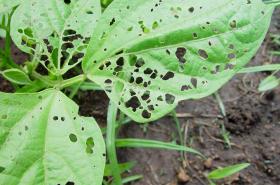
© A.M. Varela, icipe

Foliage be…

Foliage be…
Fusarium root rot (Fusarium solani f. sp. phaseoli)
Seedlings infected with Fusarium root rot appear dwarfed. The primary leaves are often yellow, later turning necrotic and finally the seedlings wilt. Fusarium species infect bean roots when the soil is too wet, or too hot for good bean growth. The fungus survives in soil for long period.
- Plough deeply bean debris after harvest.
- Practise a 6 to 8 year crop rotation without legumes.
- Do not feed livestock old bean straw if manure is to be used on bean fields.
- Plant beans in hills or ridges in heavy soils.
- Seed treatment with Trichodermaspp.. A commercial biopesticide is registered in Kenya under the name Rootgard®.
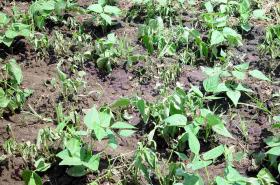
© A.M. Varela
Halo blight (Pseudomonas syringae pv. phaseolicola)
The most characteristic halo blight symptoms occur on bean foliage. Initially, small water-soaked spots resembling pin pricks appear on the lower leaf surface. These spots turn brown in a few days, and the surrounding tissue gradually become yellow-green. This zone of yellowed tissue around the spot resembles a halo, hence the name of the disease. Pod lesions first appear as small water-soaked pin pricks on the pod surface. These lesions gradually enlarge to form dark sunken spots of various sizes. A whitish bacterial ooze appears on the spots when wet.
Halos do not develop around pod lesions. Pod lesions are especially important to the French bean industry because they make the bean pod unacceptable to fresh market and processors. On dry beans, pod lesions are of less importance because the beans are shelled before marketing. When infected seed is used, the primary leaves of seedlings show interveinal chlorosis, suggestive of mosaic virus infection.
- Use certified disease-free seed.
- Plant resistant varieties (e.g. French bean variety 'Paulista').
- Practise a 2-3 year crop rotation without legumes.
- Plough under bean debris after harvest.
- Do not work in bean fields when the plants are wet.
- If blight is observed on scattered plants, spot application of copper hydroxide could be considered.
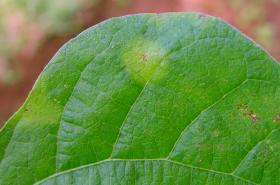
© A.M. Varela, icipe
Leafhoppers (Empoasca dolichi and E. lybica)
They are widely distributed in Africa. Leafhoppers are small (about 2.5 mm long), slender mobile insects and green in colour. They move sideways when disturbed. Numerous leafhoppers may be seen on the underside of leaves. Their feeding on beans causes down curled leaves with yellowish margins. Eventually the whole plant may turn yellowish brown and dry-up. In Africa, leafhopper damage is usually minor and does not warrant control.
- Look for leafhoppers on the undersides of leaves.
- Wash nymphs from plants with a strong jet of water. Wash the undersides of the leaves in particular.
- Set out yellow sticky traps near the infested plants if the infestation is severe. For more information on sticky traps click here
- If necessary spray insecticidal soap, neem or pyrethrum.
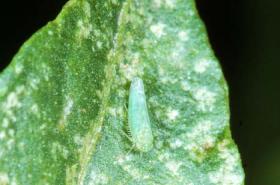
© Ooi P. (Courtesy of EcoPort, www.ecoport.org)
Leafmining flies (Lyriomiza spp)
Leafminers are small flies, about 1.5 mm in length. The maggot makes long, slender, white mines (tunnels) in leaves.
Severely mined leaves may turn yellow and drop. Severely attacked seedlings are stunted and may eventually die. Control measures are necessary when attack is severe, especially on young plants.
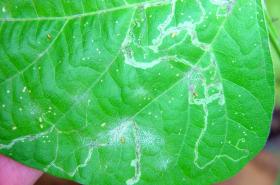
© A.M. Varela, icipe
Powdery mildew (Erysiphe polygoni)
A white powdery mould appears on the upper leaf surfaces. Severely diseased leaves turn yellow and die. Leaf petioles, stems and pods can also be affected.
- Plough under bean debris after harvest.
- Practise a 2-3 year crop rotation without legumes.
- Avoid continuous bean cropping.
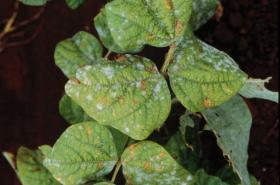
© GTZ - IPM Horticulture Project. Kenya.

Powdery mi…

Powdery mi…
Root-knot nematode (Meloidogyne incognita, M. javanica)
They cause stunting and yellowing of plants with a tendency to wilt in hot weather. If infested plants are pulled out from the soil, the roots can be seen to be distorted, swollen and bearing knots of various sizes. Infested roots under severe infestation decay.
These knots should not be confused with legume nodules, which are normally small and round, and are attached to the outside of the roots, whereas swellings of root-knot nematodes are within the body of the root. When active nodules are sliced, they are pinkish in colour.
- Practise a 2-3 year crop rotation with cereals, maize or grasses.
- Direct surface irrigation water from new to old bean fields.
- Maintain fields weed-free.
- Uproot and destroy entire plants after harvest.
- Amend soil with neem cake or green manure of marigold or sunnhemp.
- Maintain high levels of organic matter in the soil.
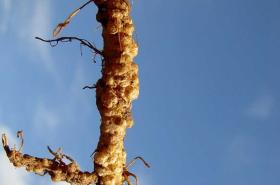
© A.M. Varela, icipe
Spider mites (Tetranychus spp.)
Spider mites feeding on bean plants may cause reduction in plant growth, flowering, number and length of pods, and number of seeds per pod. Damage is most severe when mites attack young plants. Mite damage may be particularly severe during the dry season.
- Avoid planting next to infested fields.
- Avoid frequent use of broad-spectrum pesticides, particulary pyrethroids; this may lead to spider mite outbreaks.
- Use overhead irrigation or wash plants with a strong jet of water to knock off mites and to destroy their webs. Be sure to spray the underneath of the leaves. However, this should be done early in the day to allow the foliage to dry. Wetness of the foliage for an extended period is conducive to development of fungal diseases.
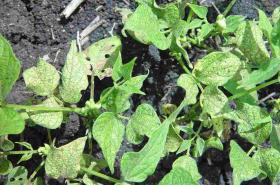
© A.M. Varela, icipe

Spider mit…

Spider mit…

Spider mit…
Storage pests: Bruchids (Zabrotes subfasciatus, Acanthoscelides obtectus)
Bruchids such as the bean bruchid or dry bean weevil (Acanthoscelides obtectus), and the Mexican bean weevil (Zabrotes subfasciatus) are storage pests, attacking dried beans in Africa. They are small beetles (3-5 mm) grey, brown to reddish-brown in colour. Females of the dry bean weevil lay eggs glued to the bean seeds, while females of the Mexican bean weevil lay eggs scattered between the bean seeds. Development takes place inside the bean and takes about one month before the adult emerges. The larvae feed on the seeds destroying them or reducing germination capacity. The adult emerges from the seeds leaving small round holes on the bean seeds. Heavy infestation can result in a large number of holed seeds, with adults moving across the stored beans. The dry bean weevil can attack pods in the field laying eggs on ripening pods. The Mexican bean weevil attacks only beans in storage.
- Bruchids can be controlled through good storage hygiene. Remove infested residues from last season's harvest.
- When small lots of beans are stored, daily turning of the storage container can significantly reduce infestation.
- Complete control of bruchids can be achieved by coating stored seeds with vegetable oil such as cotton seed or coconut oil (small or medium amounts of grain).
- Farmer experience: Solar drying of bean seeds before storage is essential. Before storage, treat or mix stored seed with a mixture of plant parts (e.g. neem, lantana, pyrethrum and others), vegetable oil (e.g. neem, coconut, castor bean, cottonseed, groundnut, maize, among others) or mineral substances (e.g. sand, diatomite among others). Diatomite is commercially available as Kensil Lagging from most hardware shops in Kenya.
- Pyrethrum (botanical) is effective in controlling weevils. For more information on Pyrethrum click here
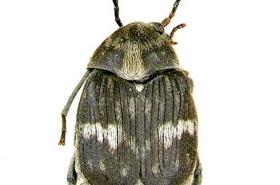
© Georg Goergen, Courtesy of EcoPort (www.ecoport.org)

Bruchid

Bruchid da…

Bruchids o…

Bruchid da…
Striped bean weevil (Alcidodes leucogrammus)
Several species of snout weevils are commonly found feeding on bean leaves. Adult weevils chew the edges of the leaves cutting circular discs. Grubs of weevils live in the soil feeding on roots or may bore into the stem of the bean plant causing swellings or galls, as is the case of the striped bean weevil.
The adult of the striped bean weevil is 10-15mm long, dark brown in colour with whitish to yellowish longitudinal stripes. The females lay eggs in the soil near bean plants. Emerging grubs bore and feed inside the stem, causing cankerous swelling or galls. Fully-grown grubs are white, about 10mm long, have no less and are C-shaped. Pupation occurs in an earthen cell attached to the plant. Plants attacked by grubs of this weevil show stunted growth, lodging, and eventually may die. The stem of the plant breaks easily during harvesting.
In Kenya, striped bean weevil only occurs occasionally, and to a minor extent and control measures are usually not required.
Beetles can be collected manually and destroyed. Plants damaged by the grubs can be removed and the grubs destroyed.
- Collect weevils manually and destroy them
- Remove plants damaged by grubs and destroy the grubs
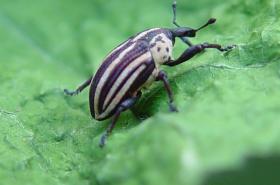
© A.M. Varela, icipe

Stripped b…

Stripped b…
Flower thrips (Frankliniella spp. and Megalurotrhips sjostedti)
Feeding by flower thrips causes scars and blemishes on leaves and pods. Flower thrips can be found feeding on young plants. They are less than 2 mm long. As soon as the plants start flowering, however, most thrips would be found in the flower buds, flowers and on the young pods. Heavy thrips feeding causes flower abortion and flower malformation. French bean pods become scarred (having a rough silvery surface) and malformed and are not marketable.
- Monitor the crop regularly. Early detection is particularly important at the onset of flowering.
- Whenever necessary spray the crop with botanicals (e.g. some plant extracts: garlic, rotenone, neem, pyrethrum, etc.). A mixture of garlic and pepper has been recommended for organic growers in USA.
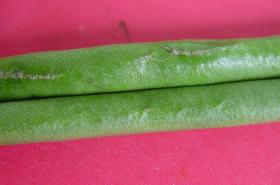
© A.M. Varela, icipe
Whiteflies (Bemisia tabaci and Trialeurodes vaporariorum)
Whiteflies are important pests of beans. Both the larvae and the adults pierce and suck the sap from leaves, which may cause reduced plant growth, yellowing of leaves, and wilting of the plant when present in large numbers. They produce honeydew, which may lead to growth of sooty mould on leaves and pods. Heavy growth of sooty mould reduces photosynthesis affecting plant growth. French bean pods contaminated with sooty mould are unmarketable.
Control measures on beans are justified if large whitefly numbers attack the plants during the early stages of the crop. Whitefly infestations after the onset of flowering usually do not affect yield.
Adults are small (1-3 mm long), with two pairs of wings that are held roof-like over the body. They resemble very small moths.
- Conserve natural enemies. Parasitic wasps are very important for control of whiteflies.
- Whenever necessary spray crop with neem products. Neem-based pesticides are reported to inhibit growth and development of immature stages, and to reduce egg laying by adult whiteflies
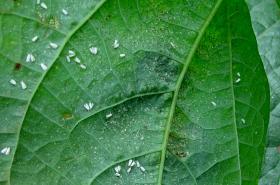
© A.M. Varela, icipe
| General Information and Agronomic Aspects | Information on Diseases | |||
| Fresh Quality Specifications for the Market in Kenya | Information Source Links | |||
| Information on Pests | Contact Information |
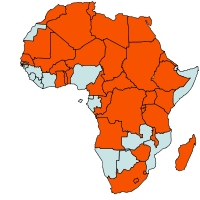 |
| Geographical Distribution of Beans in Africa |
However, presently, two distinct bean types are recognised in the region: French beans (green beans) and common beans (dry beans). French beans are the immature green pods of P. vulgaris and are primarily grown for export market to European Union and elite local urban markets. Common beans are the second most important staple food to maize for the local people.
Beans were introduced to Africa from Latin America several centuries ago. To date beans are a vital staple in Africa, providing the main source of protein. Common beans are mainly grown by women for subsistence and for the local market. French beans (green / snap beans) are grown as a cash crop by large scale and smallholder farmers. They are a major export vegetable commodity in Eastern Africa. The main producing countries in the region are Kenya, Tanzania, Uganda, and more recently Rwanda. In Kenya, most of the crop is grown by smallholders and virtually all is exported to Europe. Estimates indicate that up to 50,000 smallholder families are involved in French bean production in Kenya.
The growth habit of common beans varies from determinate dwarf or bush types to indeterminate climbing or pole cultivars. Bush beans are the most predominant types grown in Africa. However, improved climbing beans introduced to Rwanda in the 80's have since spread to other countries in the region. They are particularly grown in areas with limited land and high human population.
Nutritive Value per 100 g of edible Portion
| Raw or Cooked Beans | Food Energy (Calories / %Daily Value*) |
Carbohydrates (g / %DV) |
Fat (g / %DV) |
Protein (g / %DV) |
Calcium (g / %DV) |
Phosphorus (mg / %DV) |
Iron (mg / %DV) |
Potassium (mg / %DV) |
Vitamin A (I.U) |
Vitamin C (I.U) |
Vitamin B 6 (I.U) |
Vitamin B 12 (I.U) |
Thiamine (mg / %DV) |
Riboflavin (mg / %DV) |
Ash (g / %DV) |
| Adzuki Beans cooked | 128 / 6% | 24.8 / 8% | 0.1 / 0% | 7.5 / 15% | 28.0 / 3% | 168 / 17% | 2.0 / 11% | 532 / 15% | 6.0 IU / 0% | 0.0 / 0% | 0.1 / 5% | 0.0/ 0% | 0.1 / 8% | 0.1 / 4% | 1.3 |
| Adzuki Beans raw | 329 / 16% | 62.9 / 21%/ | 0.5 / 1% | 19.9 / 40% | 66.0 / 7% | 381 / 38% | 5.0 / 28% | 1254 / 36% | 17.0 IU / 0% | 0.0 / 0% | 0.4 / 18% | 0.0 / 0% | 0.5 / 30% | 0.2 / 13% | 3.3 |
| Black Beans cooked | 132 / 7% | 23.7 / 8% | 0.5 / 1% | 8.9 / 18% | 27.0 / 3% | 140 / 14% | 2.1 / 12% | 355 / 10% | 6.0 IU / 0% | 0.0 / 0% | 0.1 / 3% | 0.0 / 0% | 0.2 / 16% | 0.1 / 3% | 1.2 |
| Black Beans raw | 341 / 17% | 62.4 / 21% | 1.4 / 2% | 21.6 / 43% | 123 / 12% | 352 / 35% | 5.0 / 28% | 1483 / 42% | 0.0 / 0% | 0.0 / 0% | 0.3 / 14% | 0.0 / 0% | 0.9 / 60% | 0.2 / 11% | 3.6 |
| French Beans cooked | 129 / 6% | 24.0 / 8% | 0.8 / 1% | 7.0 / 14% | 63.0 / 6% | 102 / 10% | 1.1 / 6% | 370 / 11% | 3.0 IU / 0% | 1.2 / 2% | 0.1 / 5% | 0.0 / 0% | 0.1 / 9% | 0.1 / 4% | 1.6 |
| French Beans raw | 343 / 17% | 64.1 / 21% | 2.0 / 3% | 18.8 / 38% | 186 / 19% | 304 / 30% | 3.4 / 19% | 1316 / 38% | 8.0 IU/ 0% | 4.6 / 8% | 0.4 / 20% | 0.0 / 0% | 0.5 / 36% | 0.2 / 13% | 4.3 |
| Red Kidney Beans cooked | 127 / 6% | 22.8 / 8% | 0.5 / 1% | 8.7 / 17% | 28.0 / 3% | 142 / 14% | 2.9 / 16% | 403 / 12% | 0.0 IU / 0% | 1.2 / 2% | 0.1 / 6% | 0.0 / 0% | 0.2 / 11% | 0.1 / 3% | 1.1 |
| Red Kidney Beans raw | 337 / 17% | 61.3 / 20% | 1.1 / 2% | 22.5 / 45% | 83.0 / 8% | 406 / 41% | 6.7 / 37% | 1359 / 39% | 0.0 IU / 0% | 4.5 / 8% | 0.4 / 20% | 0.0 / 0% | 0.6 / 41% | 0.2 / 13% | 3.4 |
A moderate well-distributed rainfall is required (300-400 mm per crop cycle) but dry weather during harvest is essential. Drought or waterlogging are harmful. Climbing cultivars will give economic yields in areas of high rainfall but the dwarf types appear to be more sensitive to high soil moisture levels. Suitable soil types range from light to moderately heavy and to peaty soils with near-neutral pH and good drainage. Common bean is susceptible to salinity.
The optimum temperature range for growing French beans is 20-25°C, but can be grown in temperatures ranging between 14 and 32°C. Extreme temperatures result in poor flower development and poor pod set. However, French beans mature faster in warmer areas. French beans can be grown between 1000 and 2100 metres above sea level.
Rainfed cultivation is possible in areas with well distributed, medium to high annual rainfall (900-1200 mm) but to maintain a continuous production especially during the dry season, irrigation is essential. During the dry season up to 50 mm of water per week is required. This could be applied through furrow or overhead irrigation. French beans grow best on well drained, silty loams to heavy clay soils high in organic matter with pH 5.5-6.5.
For good pest and disease management avoid planting French beans too close. A spacing of not less than 30x15 cm between the rows and within the row is recommended in Kenya. New plantings should be sited up-wind where continuous bean cropping is practiced. Plant maize, cereals or sunflower between French bean fields to minimise the spread of wind-borne diseases such as bean rust.
Plant population densities are 150,000 - 200,000 plants/ha for dwarf cultivars and half that for climbing types in sole cropping. In intercropping, densities are much lower. For climbing beans, 4-6 seeds are usually sown together in hills spaced 1 m apart. They may also be sown in rows at a spacing of 90-120 x 15-30 cm. Depth of sowing is 3-6 cm. Seed rate depends on seed size and intended plant population densities, up to 120 kg/ha for dwarf beans and 60 kg/ha for climbers in sole cropping. Climbing cultivars require support by stakes or trellis up to 2.5 m in height unless they are intercropped with tall plants such as maize or sorghum - an increasingly common practice in Kenya Rift Valley - the maize or sorghum plants acting as stakes for the bean plants.
Avoid planting beans near cowpea, soybean and many other leguminous crops, that may be the source of bean flies.
| Variety | Optimal production altitude (m) | Maturity period (months) | Grain yield (t/ha) | Remarks | |||
| "Canadian Wonder (GLP 24)" | 1200-1800 | 3.0 | 1.3-1.8 | Seeds are shiny dark reddish purple, recommended for medium rainfall areas, resistant to angular leaf spot (ALS) and anthracnose but susceptible to common bean mosaic virus (CBMV) and rust | |||
"KAT/B-1"
|
1000-1800 | 2.5 | 1.4-1.9 | Seeds creamish-green, tolerant to ALS, common bacterial blight (CBB) and CBMV, tolerant to drought and heat and grows well under tree/banana shades | |||
| "KAT/B-9" | 900-1600 | 2.5-3.0 | 1.0-1.8 | Seeds brilliant red, more drought tolerant than KAT/B-1, tolerant to CBMV and rust | |||
| "KAT X16" | 900-1600 | 2-3 | 1.5-1.8 | ||||
| "KAT X56" | 900-1800 | 2.5-3.0 | 1.5-1.8 | Seeds brilliant red, tolerant to CBMV, charcoal rot and rust | |||
| "KAT X69" | 1200-1800 | 2-3 | 1.5-1.8 | Seeds red with cream flecks, resistant to CBMV and rust, tolerant to ALS and charcoal rot, susceptible to lodging | |||
| "Kenya Wonder" | 1000-2000 | 3.0-3.5 | 1.1-2.1 | Moderately resistant to ALS, CBB, CBMV and halo blight (HB) | |||
"Kenya Red Kidney"
|
1000-2100 | 2.5-3.0 | 1.1-2.8 | Moderately resistant to ALS, CBB, CBMV and HB | |||
| "KK 8" | 1500-1800 | 2.5-3.0 | 1.8-2.0 | Tolerant to root rot | |||
| "KK 15" | 1500-1800 | 2.5-3.0 | 1.8-2.0 | Tolerant to root rot | |||
| "KK 22" | 1500-1800 | 2.5-3.0 | 1.8-2.0 | Tolerant to root rot | |||
| "Miezi Mbili" | 1000-2000 | 2.5-3.0 | 1.2-2.3 | Moderately resistant to ALS, anthracnose, CBB, CBMV and HB | |||
| "Mwezi Moja (GLP 1004)" | 1200-1600 | 2-3 | 1.2-1.5 | Well suited for the drier semi-arid low rainfall areas and also performs well in medium rainfall areas during short rains, seeds are large beige or light brown speckled purple, tolerant to drought and bean fly but susceptible to HB | |||
| "Mwitemania (GLP X92)" | 900-1600 | 2-3 | 1.2-1.5 | Wide adaptability to various agro-ecological zones of low to high rainfall areas, seeds broad with brown flecks on cream, susceptible to CBMV, drought tolerant | |||
| "New Mwezi Moja (GLP X1127)" | 1000-1500 | 2.5-3.0 | 1.0-1.5 | Wide adaptability, resistant to CBMV, tolerant to rust | |||
| "Pinto Bean (GLP 92)" | 100-1500 | 3.0-3.5 | 1.2-1.7 | Wide adaptability, resistant to HB | |||
| "Red Haricot (GLP 585)" | 1500-2000 | 2.5-3.0 | 1.0-1.5 | Suitable for high rainfall areas, resistant to CBMV | |||
"Rose Coco (GLP 2)"
|
1500-2000 | 3.0 | 1.8-2.0 | Wide adaptability, recommended for medium and high rainfall areas, seeds red with cream flecks, resistant to anthracnose and CBMV but susceptible to ALS and rust | |||
| "Wairimu Dwarf" | 500-1700 | 2.5 | 1.5-1.7 | Heat tolerant, good for maize intercropping, excellent cooking qualities |
Examples of common bean varieties grown in Tanzania
- "Canadian Wonder" (characteristics as in Kenya)
- "Cheupe" (recommended altitude:above 1500 m, potential yield: 2.5-3.0 t/ha, seeds light brown, resistant to anthracnose, CBMV, HB and rust)
- "Lymungo 85" ((recommended altitude: 900-1800 m, days to flowering: 33, pod colour: yellow, potential yield: 1.2-1.5 t/ha, resistant to ALS, anthracnose, CBB and CBMV)
- "Lymungo 90" (recommended altitude: 900-1800, seeds are larger than ?Lymungo 85?, colour deep mottled red purple, yield potential; 1.2-1.5 t/ha)
- "Selian 05" (recommended altitude: 1000-1500, potential yield: 1.0-1.6 t/ha, seeds cream in colour, resistant to anthracnose, CBMV, HB and rust)
- "Selian 06" (recommended altitude below 1500 m, yield potential; 2.5-3.0 t/ha, seeds white, days to flowering: 40, resistant to anthracnose, CBMV and HB)
Example of common beans grown in Uganda
- "K 132" (Seeds large kidney shaped red with white mottled colour, maturity period: 80 days, potential yield: 2 t/ha, resistant to CBMV but susceptible to anthracnose)
| Variety | Resistance to diseases |
| "Alexander" | Anthracnose, common bean mosaic virus, rust |
| "Amy" | Anthracnose / common bean mosaic virus |
| "Emelia" | Anthracnose / common bean mosaic virus / halo blight |
| "Julia" | Anthracnose / common bean mosaic virus |
| "Lausanne" | Anthracnose / common bean mosaic virus |
| "Paulista" | Anthracnose / common bean mosaic virus / common blight / |
| "Olivia" | Common bean mosaic virus |
| "RS 1389" | Common bean mosaic virus / bean rust |
| "RS 1391" | Common bean mosaic virus / bean rust |
| "RS 1518" | Anthracnose / common bean mosaic virus |
| "Samantha" | Anthracnose / common bean mosaic virus |
| "Tanya" | Anthracnose / common bean mosaic virus / halo blight |
| "Xera" | Anthracnose / common bean mosaic virus |
Recently introduced French bean varieties in Kenya (HCDA)
- ?Bakera?
- ?Bronco?
- ?Claudia?
- ?Coby?
- ?Cupert?
- ?Espadia?
- ?Gloria?
- ?Morgan?
- ?Pekera?
- ?Rexas?
- ?Sasa?
- ?Super Monel?
- ?Tonivert?
- ?Vernando?
Hard soils with little organic matter will not give good yields of beans, unless organic matter is provided, preferably in the form of good quality compost or well decomposed farmyard manure.
For pure stands of beans it is preferable to construct slightly raised beds of maximum 1 metre width in order to limit soil compaction around the bean plants. Application of good compost in the beds will improve yields as it will improve nitrogen fixation.
Timely and thorough weeding is essential for French beans. The first weeding should be done 2-3 weeks after emergence followed by a second weeding 2-3 weeks later. During weeding slight ridging of plants will help bean plants withstand attack of bean flies.
Cultivating beans when the soil is wet encourages spread of soil-borne diseases such as anthracnose and fusarium root rot.
Shallow tillage is preferred especially in the period before flowering as damage to the roots or the collar of the plant encourages soil borne diseases. Common bean can be rain-fed or irrigated. Irrigation is beneficial in semi-arid regions, with overhead irrigation preferred over flood irrigation. In peasant farming, the crop is seldom manured. Crop rotation is necessary to limit soil borne diseases such as root-knot nematodes and fusarium root rot.
Fertilise the soil properly and plant French beans on hills or ridges where root rot could be a problem. Avoid furrow irrigation in areas prone to root rot and root-knot nematodes and fusarium.
Mulching
Mulching with straw and cut grasses helps conserve moisture, promote adventitious root development and enhances tolerance to bean fly maggot damage.
Intercropping
Beans are excellent for intercropping with other food crops, such as maize, potatoes, celery, cucumber and can help supply the other crops with nitrogen to a limited degree. Longer season varieties of beans can fix higher amounts of nitrogen than short season varieties. Intercropping with chives or garlic helps repel aphids (KIOF - personal communication).
Water management
A regular water supply is essential for French beans as moisture affects yields, uniformity and quality. Water stress during flowering reduces yields, as does waterlogging. Irrigation in dry spells is recommended as 35 mm per week at planting and 10 days post emergence, followed by 50 mm per week thereafter till end of production.
Pest and disease prevention with EM or BM
EM (Effective Microorganisms) and BM (Beneficial Microorganisms) have been shown to prevent many diseases and a few pests in various crops when sprayed on a regular basis. These are commercial products and are readily available in Kenya. It is organically acceptable and quite cheap.
Farmer practices: Solar drying of bean seeds before storage is essential. Also before storing, mix bean seeds with
a) ashes or ash/chilli mixture
b) diatomite (commercially available as Kensil Lagging from most hardware shops in Kenya)
c) store completely dry seeds in a sealed container such as a metal or plastic bucket with air tight lid, checking regularly that no weevils are developing and closing tightly again.
|
|
|
Bugs Several species of bugs feed on beans. The most common in East Africa are the spiny brown bug (Clavigralla tomentosicolis), Riptortus bugs (Riptortus dentipes), the green stink bug (Nezara viridula) and the tip wilter (Anoplocnemis curvipes).
| 
Spiny brown bug
Spiny brown bugs (Clavigralla tomentosicolis) measure about 1 cm in length. © A.M. Varela, icipe |
|
What to do:
|
|
African bollworm and other pod borers Several caterpillars are important pests as pod borers in common beans and French beans. The most common are the African bollworm (Helicoverpa armigera) and the legume pod borer (Maruca testulalis). They feed on leaves, flowers, pods and seeds.
The African bollworm caterpillars are 3 to 4 cm long. They make clean circular holes in the pods. One caterpillar may damage several pods. Caterpillars of the legume pod borer attack pods at the point of contact with other pods, leaves or the stem. They frequently web together flowers, pods and leaves with excrements. | 
African bollworm
African bollworm (Helicoverpa armigera) on beans. Caterpillars are 3 to 4 cm in length. © A.M. Varela, icipe |
|
What to do:
|
|
Storage pests: Bruchids (Zabrotes subfasciatus, Acanthoscelides obtectus) Bruchids such as the bean bruchid or dry bean weevil (Acanthoscelides obtectus), and the Mexican bean weevil (Zabrotes subfasciatus) are storage pests, attacking dried beans in Africa. They are small beetles (3-5 mm) grey, brown to reddish-brown in colour. Females of the dry bean weevil lay eggs glued to the bean seeds, while females of the Mexican bean weevil lay eggs scattered between the bean seeds. Development takes place inside the bean and takes about one month before the adult emerges. The larvae feed on the seeds destroying them or reducing germination capacity. The adult emerges from the seeds leaving small round holes on the bean seeds. Heavy infestation can result in a large number of holed seeds, with adults moving across the stored beans. The dry bean weevil can attack pods in the field laying eggs on ripening pods. The Mexican bean weevil attacks only beans in storage. | 
Bruchid
The Mexican bean weevil (Zabrotes subfasciatus) is a very small weevil, it is about 2 - 3 mm long. © Georg Goergen, Courtesy of EcoPort (www.ecoport.org) |
|
What to do:
|
|
Aphids (Aphis fabae) and (Aphis craccivora) The black bean aphid (Aphis fabae) and the black legume aphid (Aphis craccivora)
are black to dark brown brownish in colour and winged or wingless and vary in size from 1.5 to 3.0 mm. Aphids feed by sucking plant sap. Small aphid populations may be relatively harmless, but heavily infested plants usually have wrinkled leaves, stunted growth and deformed pods. Plants, in particular young plants, may dry out and die under heavy aphid attack. Heavy attack on older plants may cause crop loss by decreasing flower and pod production. Damage may also reduce seed viability. |  Black bean aphids (Aphis fabae). Heavy attack of black aphids on a French bean plant. Their seize varies from 1.5 to 3.0 mm. © A.M. Varela, icipe |
|
What to do:
|
|
Leafhoppers (Empoasca dolichi and E. lybica) They are widely distributed in Africa. Leafhoppers are small (about 2.5 mm long), slender mobile insects and green in colour. They move sideways when disturbed. Numerous leafhoppers may be seen on the underside of leaves. Their feeding on beans causes down curled leaves with yellowish margins. Eventually the whole plant may turn yellowish brown and dry-up. In Africa, leafhopper damage is usually minor and does not warrant control. | 
Leafhopper
Leafhopper - Adults are 2 mm long. © Ooi P. (Courtesy of EcoPort, www.ecoport.org) |
|
What to do:
|
Common bean diseases in the tropics are:
- Common blight (Xanthomonas axonopodis pv. phaseoli)
- Fusarium root rot (Fusarium solani f. sp. phaseoli)
- Rust (Uromyces appendiculatus var. appendiculatus)
- Anthracnose (Colletotrichum lindemuthianum)
- The bean common mosaic virus (BCMV)
- Angular leaf spot (Phaeoisariopsis griseola)
- Halo blight (Pseudomonas syringae pv. phaseolicola)
- Powdery mildew (Erysiphe polygoni)
- Root-knot nematodes (Meloidogyne spp.)
- Allen, D. J., Ampofo, J. K. O. and Wortmann, C. S. (1996). Pest, diseases and nutritional disorders of the common bean in Africa. A field guide. A CIAT/CTA publication. (ISBN: 958 9439 55 1)
- CABI (2005). Crop Protection Compendium, 2005 Edition. © CAB International Publishing. Wallingford, UK. www.cabi.org
- East African Seed Co. Ltd. Africa's Best Grower^s Guide www.easeed.com
- Elwell, H. and Maas, A. (1995). Natural pest and disease control. Natural farming Network. Zimbabwe. (ISBN: 0 7974 1429 0
- Fruits and Vegetables Technical Handbook. Published by The Ministry of Agriculture and rural Development. P.O.Box 30028, Nairobi, Kenya. Available from AIC, Kabete, NAirobi
- Maundu, M. E. (1997). Control of the black bean aphid, Aphid fabae Scop. Using neem based insecticides on French beans in Kenya. Report for GTZ-IPM-Horticulture Project. 1997. 57 pp.
- Nderitu, J. H., Buruchara, R. A. and Ampofo (1997). Integrated pest management for beans. African Highlands Initiative.
- Nutrition Data www.nutritiondata.com.
- PIP Technical Itinerary French Beans. www.coleacp.org/pip
- Seif, A.A., Varela, A.M., Loehr, B. and Michalik, S. (2001). A Guide to IPM in French Beans Production with Emphasis on Kenya. pp. 88. ICIPE Science Press, Nairobi, Kenya. (ISBN: 92 9064 142 8
- Tindall, H. D. (1983). Vegetables in the tropics. Macmillan, London and Basingstoke. 533 pp. (ISBN: 0 333 24268 8)
- Corner Shop, Nairobi. cls@mitsuminet.com
- Food Network East Africa Ltd: . info@organic.co.ke +254 0721 100 001
- Green Dreams: admin@organic.co.ke +254 0721 100 001
- HCDA. md@hcda.or.ke www.hcda.or.ke +2542088469
- Kalimoni Greens kalimonigreens@gmail,com +254 722 509 829
- Karen Provision Stores Nairobi: karenstoresltd@yahoo.com +254 20885552
- Muthaiga Green Grocers, Nairobi
- Nakumatt Supermarket info@nakumatt.net 020551809
- National Horticultural Research Centre, KARI, Thika. karithika@gmail.com. +2546721281
- Seminis East Africa seminisea@seminis.com
- Uchumi Supermarket, info@uchumi.com +25420550368
- Zuchinni Green Grocers, Nairobi: +254 204448240

 Back
Back
